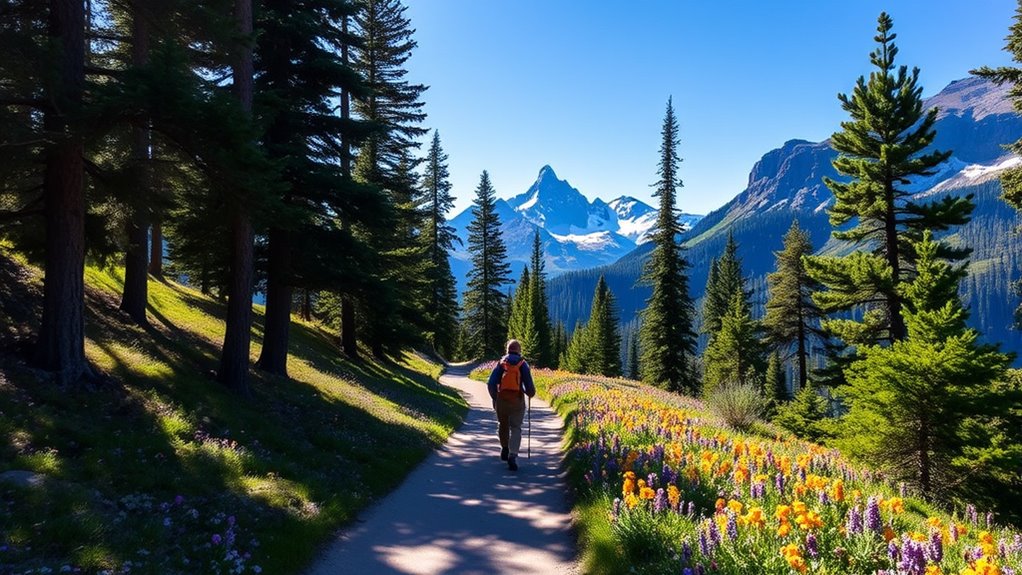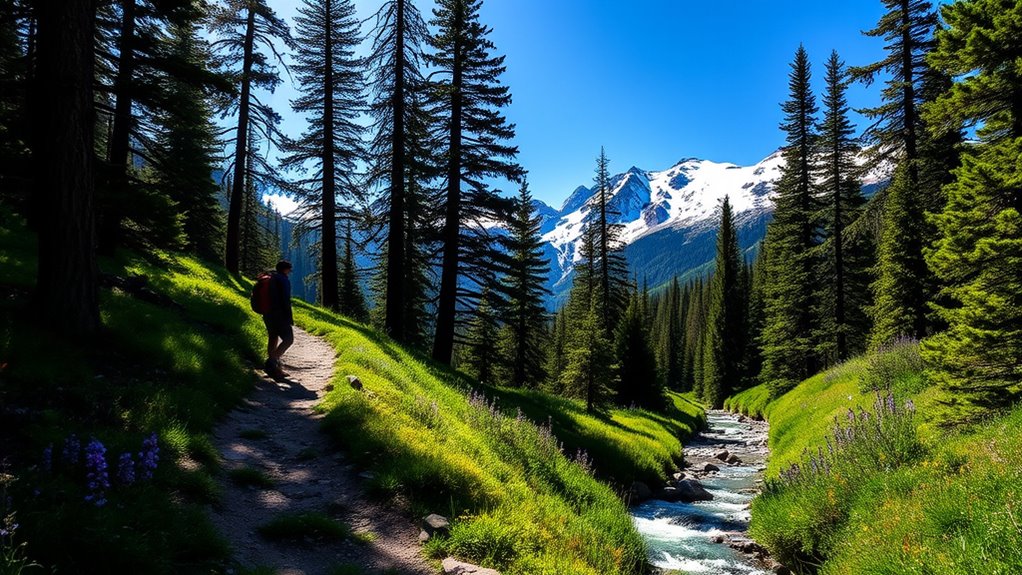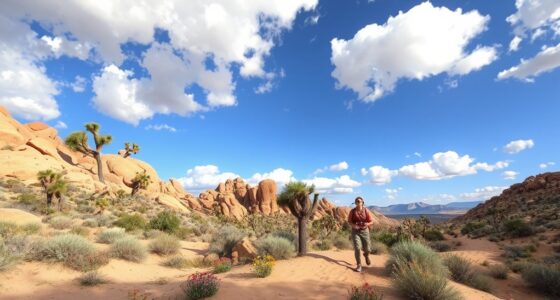Low-impact hiking in Glacier National Park is essential for preserving the park’s stunning landscapes and diverse ecosystems. Stick to established trails to protect native plants and reduce soil erosion. Always prioritize safety by checking trail conditions and carrying bear spray. Keep a safe distance from wildlife, and remember to leave no trace by cleaning up after yourself. By practicing these principles, you help safeguard the park’s beauty for future adventurers. There’s more to discover about hiking responsibly here.
Key Takeaways
- Stick to established trails to protect native plants and prevent soil erosion in Glacier National Park.
- Carry out all trash and waste to minimize your environmental footprint and preserve the park’s beauty.
- Use biodegradable products and avoid introducing non-native species by cleaning gear before hiking.
- Observe wildlife from a distance and never feed or approach animals to ensure safety for both hikers and wildlife.
- Stay mindful of your surroundings, appreciating nature while practicing low-impact techniques to maintain the park’s integrity.

If you’re looking for an unforgettable adventure, hiking in Glacier National Park should be at the top of your list. The park’s breathtaking landscapes and diverse ecosystems offer incredible experiences, but it’s essential to hike responsibly. Low-impact hiking not only preserves the stunning environment but also guarantees that you have safe and enjoyable wildlife encounters.
Hiking in Glacier National Park offers breathtaking beauty and unforgettable experiences, but responsible, low-impact practices are essential for preserving its wonders.
When you set out on your hike, remember that you’re not just a visitor; you’re a part of the delicate ecosystem. To minimize your impact, stick to established trails. This not only protects native plants but also maintains the integrity of the environment for future hikers. As you walk, watch your step and avoid trampling on delicate vegetation. Keeping your group on the path helps prevent soil erosion and preserves the natural beauty of the park.
Trail safety is another crucial aspect of your hiking experience. Before you set out on your journey, familiarize yourself with the trail conditions. Check the weather forecast and consider the terrain. Bring maps or download trail apps to stay oriented. Always let someone know your plans, especially if you’re exploring less-traveled paths. It’s also wise to carry a basic first-aid kit, snacks, and plenty of water. Hydration is key, especially in the higher elevations of Glacier.
Wildlife encounters are one of the highlights of hiking in Glacier, but they come with responsibilities. Keep a safe distance from animals, and never approach or feed them. It’s essential to respect their space to avoid startling them, which could lead to dangerous situations. If you spot a bear or other wildlife, calmly back away and give them room. Carry bear spray and know how to use it; being prepared is vital for both your safety and the animals’. Understanding the psychological motives behind wildlife behavior can enhance your hiking experience.
As you hike, take a moment to pause and appreciate your surroundings. Listen to the sounds of nature, breathe in the fresh mountain air, and soak in the stunning views. Practicing low-impact hiking allows you to enjoy all that Glacier National Park has to offer while guaranteeing that you leave no trace behind. By being mindful of your actions, you’ll help preserve this majestic landscape for generations to come. So lace up your boots, grab your gear, and get ready for an unforgettable adventure in one of America’s most beautiful national parks!
Frequently Asked Questions
What Are the Best Times of Year for Low-Impact Hiking?
The best times for low-impact hiking are spring and fall. During spring, you’ll enjoy the vibrant blooms and active seasonal wildlife, but be cautious of muddy trails due to melting snow. In fall, the cooler temperatures and changing foliage create stunning scenery while minimizing trail erosion. Avoid summer’s peak heat and crowded trails; instead, choose these shoulder seasons for a more serene experience, where you can appreciate nature without causing damage.
Are There Any Guided Low-Impact Hikes Available?
Absolutely, you can find guided low-impact hikes that enhance your experience! Imagine wandering through a vibrant tapestry of wildflowers while learning proper trail etiquette. Local guides often lead tours that focus on nature’s wonders and sustainable practices. These hikes not only help you identify various wildflower species but also instill a respect for the environment. So, lace up your boots and get ready to explore with knowledgeable companions!
How Can I Minimize My Environmental Footprint While Hiking?
You can minimize your environmental footprint while hiking by following Leave No Trace principles. Stay on marked trails to prevent soil erosion and protect local flora. Pack out all trash, including food scraps, and avoid picking plants or disturbing wildlife. Participate in trail maintenance if possible, helping keep paths clear and safe for others. By respecting nature and fellow hikers, you’ll contribute to preserving the beauty of the outdoors for future generations.
What Gear Is Recommended for Low-Impact Hiking?
When it comes to low-impact hiking, “less is more.” You’ll want to invest in lightweight footwear that offers comfort and support without adding unnecessary weight. Opt for biodegradable supplies like eco-friendly soap and reusable containers to minimize waste. A good backpack made from sustainable materials will keep your gear organized without harming the environment. Don’t forget a refillable water bottle to stay hydrated while reducing plastic use. Happy hiking!
Are Pets Allowed on Low-Impact Hiking Trails?
Pets aren’t allowed on most low-impact hiking trails due to strict pet policies and trail regulations. You’ll want to check specific trails for exceptions, but generally, keeping your furry friends at home is best for their safety and the environment. If you’re planning to hike with a pet, consider designated areas or parks that welcome animals. Always follow the rules to help preserve the trails for everyone to enjoy.
Conclusion
As you step onto the trail, the whispers of nature beckon you deeper into Glacier National Park’s untouched beauty. Each quiet footfall reveals hidden wonders—shimmering lakes, towering peaks, and the rustle of wildlife. But wait, what’s that rustling in the bushes just ahead? Your heart races with anticipation as you draw closer. The thrill of discovery hangs in the air, and you realize this low-impact hike isn’t just a journey; it’s an adventure waiting to unfold.










